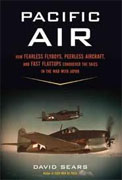Pacific Air
David Sears
book reviews:
· general fiction
· chick lit/romance
· sci-fi/fantasy
· graphic novels
· nonfiction
· audio books
· author interviews
· children's books @
curledupkids.com
· DVD reviews @
curledupdvd.com
newsletter
win books
buy online
links
home
for authors
& publishers
for reviewers

 |
Pacific Air: How Fearless Flyboys, Peerless Aircraft, and Fast Flattops Conquered the Skies in the War with Japan David Sears Da Capo Press Hardcover 408 pages May 2011 |
|
Students of World War II know that a large part of the war in the Pacific Ocean against the Japanese consisted of huge carrier battles, where enemy ships never saw each other and the war took place among the planes in the sky. These planes were based on aircraft carriers and the war was a back-and-forth battle between these planes to try and sink the enemy carriers before your own were sunk. Pacific Air
Once Sears gets back into the war and gives readers the background on the main pilots he is going to be following, such as "Butch" O'Hare (the Chicago airport is named after him), Pacific Air Many of these people we are getting to know don't make it through the war, and Sears paints full enough portraits of them to make their losses felt as well. It’s interesting seeing the war from their points of view. We often get a detailed history of what happened in the war, the strategy and tactics, why something happened. Pacific Air Even more interesting is that we get at least one view from the Japanese side. Sears traces the career of Ensign Saburo Sakai from his training days (the details of the brutality of the Japanese military to even their own members is quite striking) all the way to the end of the war. This adds a good opposite picture to the American carrier pilots. It's intriguing to see the initial elation of the Japanese carrier pilots after Pearl Harbor, the confidence they carried with them as they overran the Pacific Ocean, and the disheartening blows as the Americans slowly rose up and punished them. Sears also includes an extensive bibliography, a list of carrier pilots with their accomplishments and fates—and a note system that is a major annoyance. I hate endnotes where there are no superscripted numbers. Instead, the notes quote part of a line from a page and tell you more information about that passage. The problem is that you're not alerted to when a note is there. You have to be paying just as much attention to the notes as you do the text itself. After a while, I stopped bothering. Again, this is not a definitive history of the Pacific War. When the carrier battles are over (the "Marianas Turkey Shoot" in 1944 is where the Japanese naval aviation arm is almost totally destroyed), the book ends. Sears does relate what happened to those pilots who were still alive at the end of the war, a great wrap-up to the book. Pacific Air Originally published on Curled Up With A Good Book at www.curledup.com. © Dave Roy, 2011 |
|
|
|
 Click here to learn more about this month's sponsor! |
|
| fiction · sf/f · comic books · nonfiction · audio newsletter · free book contest · buy books online review index · links · · authors & publishers reviewers |
|
| site by ELBO Computing Resources, Inc. | |
 Sears begins with the aircraft themselves, detailing how before the war, Grumman became one of the mainstays for the building of naval aircraft. He talks about the flight tests, the strengths and weaknesses of some of the first planes to fly off the assembly line. It is important to get a basic understanding regarding what these pilots were actually flying. However, while the first chapter starts with the reaction of the factory higher-ups when the attack on Pearl Harbor was announced (they were opening a new plant on the same day), and the second tells us about the first naval pilot casualties as they attempt to land in Hawaii and were shot at by panicked ground gunners, this does not make a riveting story for those readers just beginning the book.
Sears begins with the aircraft themselves, detailing how before the war, Grumman became one of the mainstays for the building of naval aircraft. He talks about the flight tests, the strengths and weaknesses of some of the first planes to fly off the assembly line. It is important to get a basic understanding regarding what these pilots were actually flying. However, while the first chapter starts with the reaction of the factory higher-ups when the attack on Pearl Harbor was announced (they were opening a new plant on the same day), and the second tells us about the first naval pilot casualties as they attempt to land in Hawaii and were shot at by panicked ground gunners, this does not make a riveting story for those readers just beginning the book.